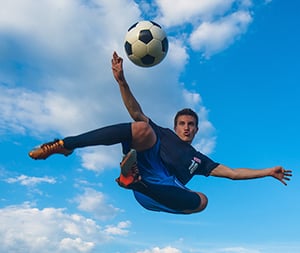Can you get a patent on a football trick?
 We have both seen many original football tricks over the years from the Cruyff Turn to Zidane's Marseille Turn, but could you patent such a trick? We had never really given it any thought. However, when we did, it turned out to be a good example of the requirements an invention has to meet in order to be patentable.
We have both seen many original football tricks over the years from the Cruyff Turn to Zidane's Marseille Turn, but could you patent such a trick? We had never really given it any thought. However, when we did, it turned out to be a good example of the requirements an invention has to meet in order to be patentable.
Four criteria
The European Patent Convention stipulates a number of criteria that an invention has to meet in order to qualify for a patent. By checking the football trick against these, it becomes clear where the nuances of the criteria lie.
1.TechnicalThe first requirement is that an invention has to be technical. A lot of people associate this term with factories and production lines, but fortunately this is too limited. In the case of the football trick, we could see the ball as a technical object that goes through a number of steps in cooperation with another technical object: the football boot. With that, criterion 1 appears to be attainable.
2. NovelThis brings us to the second point: is the invention novel? And by novel we mean unknown to anyone other than the inventor or his inner circle. An article on a website or a demonstration at an exhibition is reason enough not to grant a patent on the invention. This presents a minor challenge for the football trick. Until the patent application is filed, it should only be performed individually or at a private training session.
3. Industrial applicability
This brings us to the next question, is the football trick industrially applicable? This is a case that can be made for any professional football player. A look at the financial accounts of the average professional club says it all. The trick increases the scoring chances in a match, and thus gives a commercial advantage in the football industry. Besides that it obviously also boosts the personal branding that every popular player has nowadays. Sponsorship deals are easy to come by and thanks to rising shirt sales, the club also benefits.
4. Inventive step
Even after those three points, the patent is not in the bag yet. What remains is the question of inventive step, is the invention not obvious? This is often the most hotly debated issue when it comes to a patent being granted or not. In the case of Zidane's Marseille Turn, the European Patent Office would ask whether a footballer would be inclined to perform this move if a similar pass, such as the Cruyff Turn, is already known. In both cases, an opposing player is passed, but the way in which it is done (by drawing the ball back behind the standing leg or otherwise, by spinning 360 degrees or otherwise) and the result (running direction in relation to the opponent) are completely different and may indicate inventive step.
But alas, just when we think we have won, the Germans score in the last minute...
Apart from the criteria that an invention has to meet in order for a patent to be granted, the European Patent Convention also mentions some specific cases that are excluded from patentability.
Rules and methods for playing games
Schemes, rules and methods for playing games are excluded from patentability. The European Patent Office would probably argue that the problem to be solved underlying the football trick lies entirely in a method for playing a game and therefore cannot constitute a basis for inventive step.
To my knowledge, nobody has ever tried to patent a football trick and the efforts appear to fail on inventive step. However, a method of putting a golf ball was once successfully patented under US patent law. On the other hand, British rugby player Jonny Wilkinson did not succeed in patenting his 'cradle’ kick.
But regardless of whether or not it is possible to provide protection, this does provide a glimpse into the basic principles of patent law. And if you have been secretly practising for years in a fenced-off square and suddenly see that childhood dream come true, then please do not hesitate to contact us!

About the author
Driven by my fascination with biology, medicine, and medical technology, I studied technical medicine at the University of Twente. My Ph.D. and postdoctoral research at UMC Utrecht combined clinical...
More about Michiel >